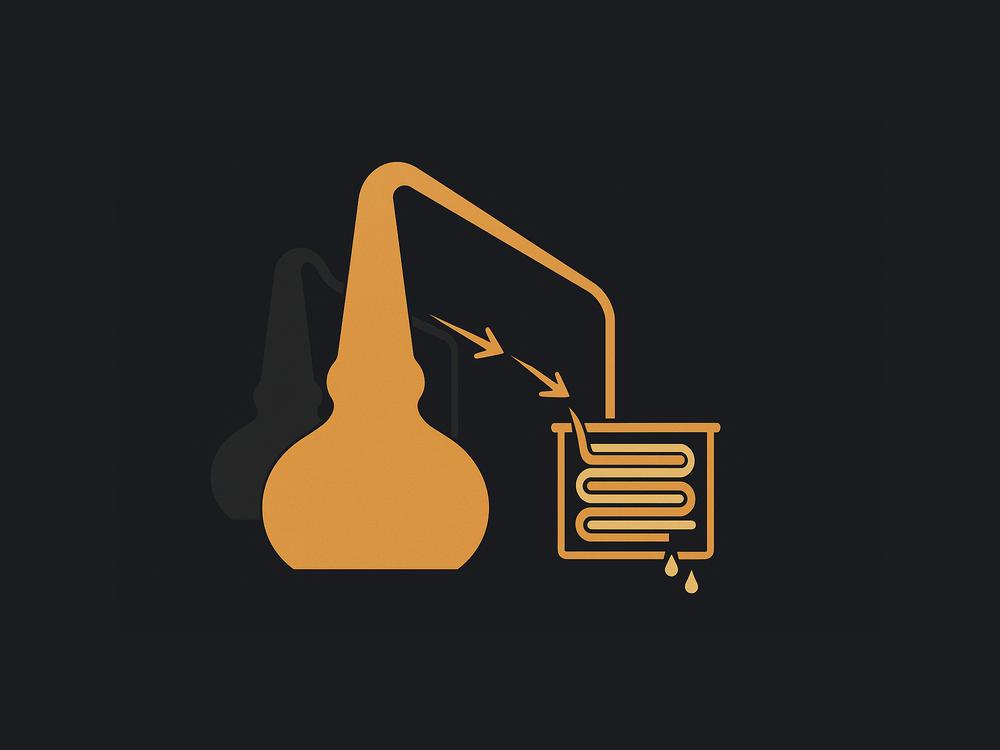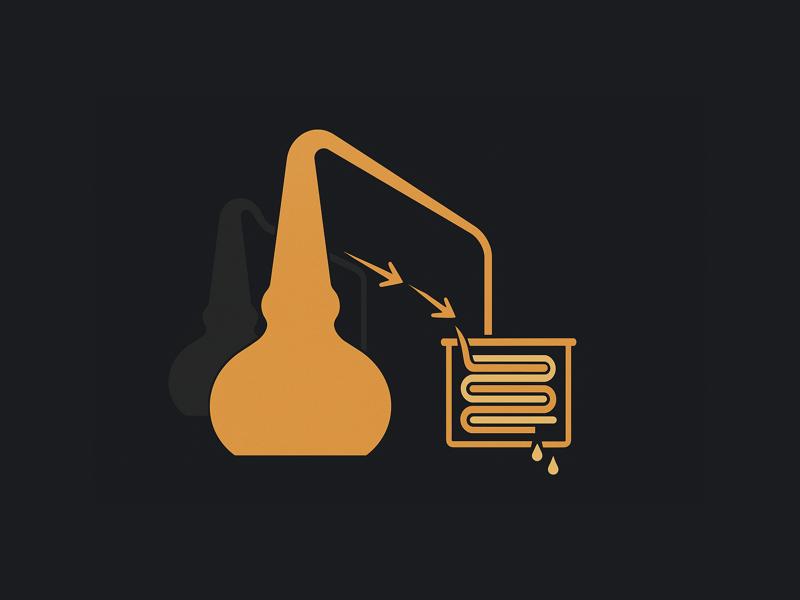Pot stills in whisky
Published August 12, 2025
Contents

Pot stills are the classic, batch distillation vessels that shape many of the world’s most characterful whiskies. If column stills are about efficiency and consistency, pot stills are about selective concentration-using copper, heat, and time to gather congeners (flavour compounds) into a style.

What is a pot still?
A pot still is a closed copper kettle that boils a fermented wash (or beer) so alcohol-rich vapour rises, travels through a neck and arm, and is condensed back to liquid. Each run is discrete: you charge the still, heat, make your cuts (heads/hearts/tails), and empty-then repeat.
Core parts (anatomy):
- Boiler (the “pot”) - Usually copper; its shape (onion, boil ball, lantern) affects reflux and copper contact.
- Neck & swan/outlet - Controls vapour speed and reflux; taller/narrower ≈ lighter spirit.
- Lyne arm - Angle matters: upward encourages reflux (lighter), downward pushes heavier oils.
- Condenser - Either a worm tub (coiled tube in a water bath; heavier style, less copper) or a shell-and-tube (more copper contact; cleaner style).
- Spirit safe / receivers - Where the distiller selects foreshots (heads), heart (new-make), and feints (tails).
How pot still distillation works (step-by-step)
- Charge the wash still with fermented wash.
- Heat (steam or direct fire). Ethanol and volatiles vaporise first.
- First distillation (stripping): Collect low wines.
- Second distillation (spirit run): Redistill low wines (often with recycled feints).
- Cuts:
- Heads/foreshots (solventy, estery) → set aside.
- Heart (clean spirit, target profile) → keep as new-make.
- Tails/feints (oily, heavier) → recycle for the next run.
- Optionally a third run (common in parts of Ireland) for extra refinement.
Pot stills are batch systems. For a primer on continuous (column) distillation and how it contrasts, see our guide to continuous distillation.
Pot still vs column still: the practical differences
- Batch vs continuous: Pots run in cycles; columns run steadily for days.
- Congener profile: Pots generally retain more heavier congeners (body, texture); columns can be tuned for higher purity and lighter style.
- Copper contact & reflux: In pots, shape (height/neck/boil ball), lyne arm angle, and condenser type set reflux and sulphur removal; in columns, plate/packing count and reflux ratio dial purity.
- ABV off still: Pot “hearts” are typically lower than neutral-flavour-forward; columns can reach much higher strengths.
- Scale & consistency: Pots favour character and small-to-medium scale; columns shine for volume, fuel economy, and uniformity.
Why copper matters
Copper is not just tradition-it reacts with sulphur compounds (e.g., mercaptans), scrubbing off off-notes and shaping fruit/meat/ester balance. More copper contact (taller necks, shell-and-tube condensers) usually means cleaner, brighter spirit; less contact (short stills, worm tubs) often yields meatier, weightier spirit.
The role of pot stills by region
Scotland (Scotch)
- Single Malt Scotch must be batch distilled in pot stills at a single distillery.
- Typical regime: double distillation (wash still → spirit still). Some distilleries triple distil.
- House style levers: still shape/size, lyne-arm angle, worm tub vs shell-and-tube, cut points, charge strength, and heating regime.
- Blended Scotch: pot-distilled malt whisky provides aroma/texture; column-distilled grain whisky brings volume and lightness.
Ireland
- Single Pot Still whiskey is uniquely Irish: a mash of malted and unmalted barley distilled in pot stills-traditionally triple distilled for a silky, spicy profile (triple isn’t mandatory, but common).
- Blends: Many Irish blends combine pot-still whiskey with grain whiskey from columns, balancing creaminess and lift.
United States
- Bourbon & rye are not tied to a still type by law. In practice, large producers use a beer (column) still plus a doubler/thumper (a secondary pot-style redistillation) for efficiency and consistency.
- Pot-still bourbons/ryes exist-especially among craft distillers-and American single malt often leans on copper pot stills to mirror Scotch technique.
- Style impact: Pot-distilled American whiskeys often show more weight and congeners at a given proof than column-only spirits.
Elsewhere (Japan, Taiwan, Australia, Europe), malt whisky traditions largely mirror Scotland’s: copper pot stills for batch character; columns for grain and neutral bases.
How pot stills shape flavour (the levers)
- Still height & neck diameter: Taller/narrower = more reflux → lighter, fruitier new-make; shorter/wider = heavier, oilier.
- Boil ball / reflux bulb: Increases surface for re-condensation; moderates weight.
- Lyne arm angle: Upward promotes reflux; downward favours carryover of heavier compounds.
- Condenser choice: Worm tub (rapid cooling, less copper) → savoury/meaty weight; shell-and-tube (gradual cooling, more copper) → cleaner/bright.
- Cut points & timing: Earlier cut to hearts = brighter/fresher; later cut = more depth, oils, and “funk.”
- Charge composition & fill level: Low wines/feints ratio and volume change vapour speeds and contact time.
- Heat input: Steam vs direct fire (and how hard you run) alters Maillard/caramelisation at hot spots and impacts reflux behaviour.
Pros and trade-offs of pot stills
Pros
- Richer textural palate; distinctive distillery character
- Cut-by-cut control for style
- Heritage appeal; transparency prized by enthusiasts
Trade-offs
- Lower throughput; more labour and energy per litre
- Batch variability; more sensitivity to operator skill
- Harder to hit very high ABVs without losing character
FAQs
Do pot stills always make heavier whisky?
Not always-tall stills, upward lyne arms, and clean condensers can produce surprisingly light pot-still spirits.
Is triple distillation automatically “smoother”?
It can be, because extra redistillation removes more congeners, but cuts, copper contact, and cask choices often matter more.
Can you mix pot and column spirit?
Yes-blends do this routinely to balance character and drinkability.
Key takeaways
- Pot stills are batch copper kettles that concentrate flavour via reflux and copper contact.
- Shape, condenser, and cut strategy are the big levers of style.
- Scotch malt and Irish pot still whiskey rely on pot stills for identity; American whiskey uses both systems, with pot stills increasingly common in craft and single malt.
- For a deeper dive into how columns differ (plates, reflux ratios, continuous operation), read our guide to continuous distillation.
Previous

